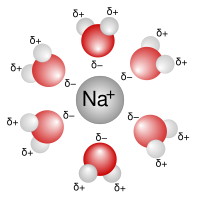
Photo from wikipedia
Abstract While solvation dynamics plays an important role in many processes, most available studies focus on the solvent response to the variations of charge distribution on dissolved solute, and the… Click to show full abstract
Abstract While solvation dynamics plays an important role in many processes, most available studies focus on the solvent response to the variations of charge distribution on dissolved solute, and the solvent response to the structural and geometrical variations of solute is rarely explored. Herein, by using dynamical density functional theory, we study the solvation dynamics of simple solvent in response to the variations of solute size and potential strength. We find that increasing solute size causes opposite effect of increasing its potential strength on solvation time. On the solvent structure, varying solute’s potential strength brings a long-range yet weak influence while changing solute size generates a short-range yet strong effect, and therefore the penalty in solvent free energy is generally dominated by the change in solute’s potential strength while the variations of coordination number and solvation shell radius are dominated by the change in solute size. This work unravels the nonpolar solvation dynamics in response to the variation of solute geometry, and casts helpful insights on the design and control of solvation-dynamics related applications in molecular engineering.
Journal Title: Chemical Engineering Science
Year Published: 2020
Link to full text (if available)
Share on Social Media: Sign Up to like & get
recommendations!